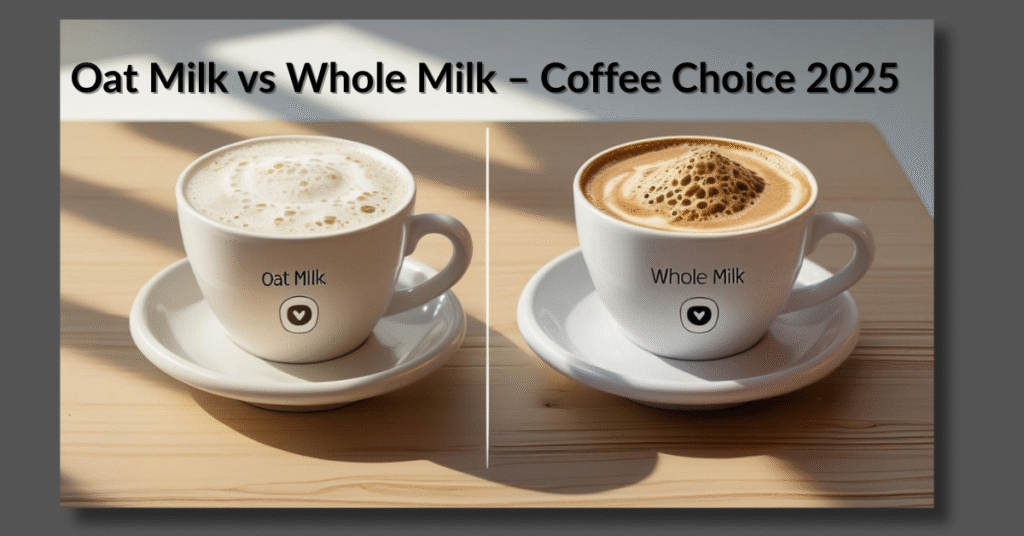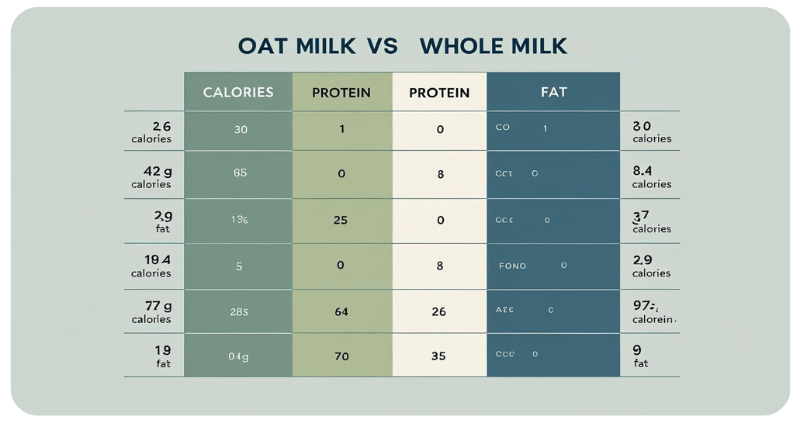If you’re a coffee lover, you’ve likely asked yourself: “Oat milk vs whole milk — which one makes a better cup in 2025?” Whether you’re brewing espresso at home or grabbing a latte from your local café, the milk you choose can make or break your experience.

In this post, we’ll compare oat milk and whole milk side by side—from taste and texture to nutrition and sustainability—to help you make the best choice for your daily coffee.
Why Milk Choice Matters in Coffee
The milk you use affects:
- The flavor of your coffee
- The creaminess and body
- How well it froths for lattes and cappuccinos
- The nutrition you get with every cup
In 2025, more people are turning to plant-based options. But is oat milk really better than whole milk for coffee—or is it just a trend?
Let’s find out.

🆚 Oat Milk vs Whole Milk: Quick Comparison Table
| Feature | Whole Milk | Oat Milk (Barista Blend) |
|---|---|---|
| Taste | Rich, creamy, slightly sweet | Mild, naturally sweet, oaty flavor |
| Frothing Ability | Excellent for latte art | Great (especially barista versions) |
| Calories (per cup) | ~150 kcal | ~120 kcal |
| Fat Content | 8g (mostly saturated) | 5g (mostly unsaturated) |
| Protein | 8g | 3g |
| Lactose-Free | ❌ No | ✅ Yes |
| Vegan-Friendly | ❌ No | ✅ Yes |
| Environmental Impact | Higher (more water/feed for cows) | Lower (sustainable, less water use) |
Taste Test: Which One Wins?
✅ Whole Milk: The Classic Coffee Companion
- Adds a velvety mouthfeel to coffee
- Naturally balances the acidity of espresso
- Creates smooth, rich cappuccinos
For those who prefer a classic coffee flavor, whole milk remains the top choice. It’s especially popular in Italian-style espresso drinks.
✅ Oat Milk: The Plant-Based Challenger
- Offers a mild oat-like sweetness that pairs well with light roast coffees.
- Doesn’t overpower coffee
- Popular with vegans and people with lactose intolerance
Modern barista oat milks are formulated to mimic the creaminess of dairy—making them a solid alternative.

Frothing and Steaming: Who’s Got the Edge?
Whole Milk:
- Froths easily with microfoam
- Ideal for latte art
- High protein content helps form stable foam
Oat Milk:
- Froths surprisingly well—especially barista blends
- Produces creamy foam with slightly larger bubbles
- May need practice to steam just right
Tip: If you’re using oat milk at home, choose barista-style oat milk for the best frothing results.

Health & Nutrition: Which is Better?
Whole Milk:
- Rich in calcium, vitamin D, and protein
- Contains a higher amount of saturated fat, which many individuals aim to reduce in their diets.
- Not suitable for lactose-intolerant individuals
Oat Milk:
- Lower in protein
- Fortified with calcium and vitamins
- Naturally lactose-free and vegan
- Contains beta-glucans (heart-healthy fiber)
✅ Verdict: If you’re watching fat intake or want a plant-based option, oat milk is a great choice. For higher protein, stick with whole milk.
Sustainability: Which Is Greener?
Whole Milk:
- Dairy farming uses more water, land, and feed
- Generates higher greenhouse gas emissions
Oat Milk:
- Requires significantly less water to produce
- Low carbon footprint
- More environmentally friendly in 2025 than dairy or even almond milk
🌱 Contains a higher amount of saturated fat, which many individuals aim to reduce in their diets.

💡 Practical Tips: Choosing the Right Milk for You
Here’s how to decide between oat milk vs whole milk based on your lifestyle:
✔️ Choose Whole Milk If You:
- Love creamy, traditional coffee
- Need more protein and calories
- Don’t have lactose intolerance
✔️ Choose Oat Milk If You:
- Follow a vegan or plant-based diet
- Want to reduce your carbon footprint
- Prefer a lighter, sweeter taste in coffee
Coffee Trends in 2025: What Are People Choosing?
In 2025, coffee shops worldwide are offering oat milk as a standard option, not just a specialty request.
- Barista oat milk sales are up globally
- Many cafés are making oat milk their default dairy-free choice
- More consumers are choosing sustainable milk options
So, even if you’re a whole milk fan, don’t be surprised if oat milk becomes the new normal in your next latte.
✅ Conclusion: So, Which One Is Better for Coffee in 2025?
If we had to crown a winner in the oat milk vs whole milk debate for coffee in 2025, here’s the final word:
- Flavor and foam-wise, whole milk continues to be the go-to for those who love a traditional coffee experience.
- Health & Lifestyle: Oat milk is more inclusive and heart-healthy
- Sustainability: Oat milk is the clear winner

☕ Final Recommendation:
Try both. Your perfect cup might depend on the coffee roast, how you brew it, and your personal health or environmental goals.
👉 Love experimenting with coffee? Download our FREE guide: “Top Coffee Recipes for Plant-Based Milks in 2025” – filled with barista tips, milk pairings, and more.
FAQs About Oat Milk vs Whole Milk
Q1. Is oat milk good for coffee?
Yes! Oat milk has a smooth, creamy texture and a mild flavor that blends well with coffee, especially when steamed or frothed.
Q2. Does oat milk curdle in coffee?
Oat milk can curdle in very acidic or overly hot coffee. To prevent this, use barista blends and avoid overheating.
Q3. Which milk has more protein?
Whole milk contains significantly more protein—about 8g per cup, compared to oat milk’s 2–3g per cup.
Q4. Can I make latte art with oat milk?
Yes, definitely! Barista-style oat milk is formulated to froth and stretch well, making it perfect for latte art.
Q5. Which milk option is more eco-friendly: oat milk or whole milk?
Oat milk is considered far more sustainable. Its production requires less water, land, and energy, while producing fewer greenhouse gas emissions than dairy farming.
Ready to upgrade your daily coffee experience in 2025?
Try both options and see what suits your taste and values best!
📩 Have questions about healthy kitchen upgrades or sustainable living tips? Contact us here or explore more on our blog!
Disclaimer
This article is for informational purposes only and should not be taken as medical or nutritional advice. Please consult a healthcare professional for guidance specific to your health or diet.
